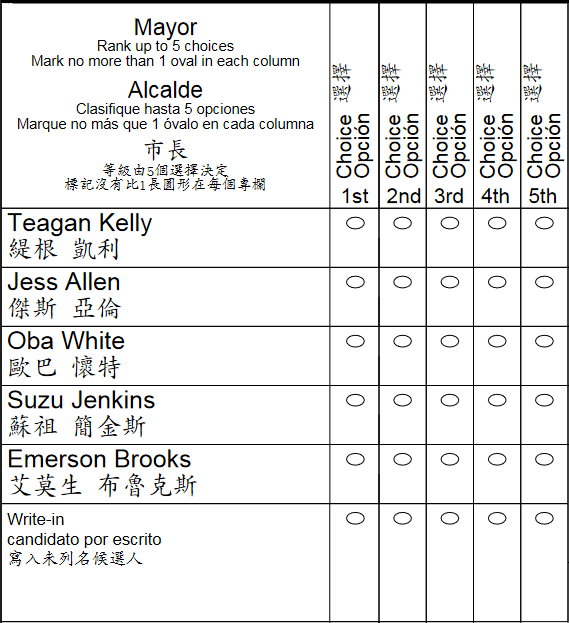This year, New York City will implement ranked choice voting (RCV) for the first time in citywide elections.
RCV helps alleviate many of the complaints about today’s political system, including candidates winning without majority support, overtly negative campaigns, and the lack of diversity. But how does it work? Here we explain everything you’ll need to know about RCV before this June’s primary elections.
What is ranked choice voting (RCV)?
Rather than voting for just one candidate in any race, voters can choose up to five candidates, ranked according to their preference.
How does it work?
If one candidate gets a majority of votes – more than 50% of the first-choice votes – they win, just like in a regular election. However, that’s rare in races with many candidates. When no candidate has above 50% of the first-choice votes, that’s where ranked choice voting makes a difference.
Candidates are ranked according to the number of their first-choice votes. With no candidate over 50%, the candidate with the fewest first-choice votes gets eliminated. Everyone whose first choice was for that eliminated candidate then gets their second-choice vote allocated to their second-choice candidate. For example, if you ranked Candidate Green as your first choice and Candidate Blue as your second choice, once Candidate Green is eliminated, Candidate Blue gets your vote.
Candidates keep getting eliminated, and their second (third, etc.) choice votes get allocated to other candidates, for as long as necessary until one candidate has over 50% of the vote.
Confused? Check out the video below from the NYC Board of Elections to see a visual explanation.
For information on how an RCV ballot will look like on an electronic voting machine, click here.
For which races will RCV apply?
This year, the races for Mayor, Public Advocate, Comptroller, Borough President, and City Council will use RCV.
RCV does not apply to state or federal races, District Attorney, or judgeships.
What are the benefits?
RCV gives voters more power! There are many benefits, including:
- There are more choices for voters — you can choose and rank up to five candidates, rather than settling for just one.
- The winning candidate must receive a majority of votes, meaning they have to appeal to a wide variety of voters and not just a polarized minority. This means the most people get to see one of their top choice candidates win.
- It reduces the likelihood of negative campaigning, since candidates want to attract the second and third choice preferences of voters who may be supporting an opponent. This also helps prioritize issues over attacks.
- Voters don’t have to choose between the candidate they like best and the candidate they feel has the best chance of winning — you can vote your heart, and if your candidate doesn’t win, your vote will go to your next choice.
- It makes it easier for people to vote and saves taxpayer dollars, by requiring ONE election to determine the winning candidate. RCV eliminates the need for a costly runoff election where even fewer people get to the polls.
- RCV helps increase the diversity of elected officials — more women, people of color, and younger candidates win elections when voters have the ability to rank their candidates according to their real preferences instead of guessing which candidate may or may not have a chance of winning.
- RCV helps to level the playing field for candidates. By making it important for candidates to consider voters who may rank them 2nd or even 3rd, it becomes more valuable to reach more voters through the grassroots than to merely spend a lot of funds targeting small niches of voters just to win.
Why is New York City using RCV now?
In 2019, voters approved Ballot Question #1 by an almost three-to-one margin, setting up Ranked Choice Voting to be implemented in the next citywide election.
Has this been done before?
Yes! RCV has been successfully implemented in major cities like Minneapolis and San Francisco, and even statewide in Maine. Click here for the full list of locations where RCV is used in the United States.
So how should I go about voting now?
- It’s simple. Vote your issues, your passions, and your heart. Select and rank up to five candidates. For the person you want to win most, rank them #1. Then rank everyone else.
- Be sure to rank every single candidate that you would be okay with winning. This way your votes will be included in as many rounds of “voting” that need to take place to find the majority candidate.
Sample Mayoral Ballot with RCV
Are there any disadvantages?
Some people think that RCV is too complicated for voters to understand. We disagree! Learn more about RCV and spread the word to your family and friends so we can enjoy a voting process that will lead to a more democratic, diverse, and engaging system.
Important Dates to Remember
Registration Deadline: May 28
Early voting starts: June 12
Absentee ballot application due by: June 15
Primary: June 22
Have a question about ranked choice voting? Send us an email at [email protected] and we’ll get you an answer!
